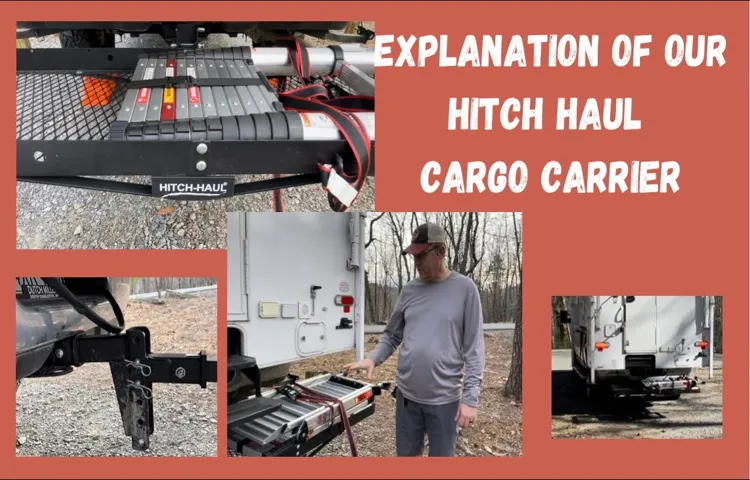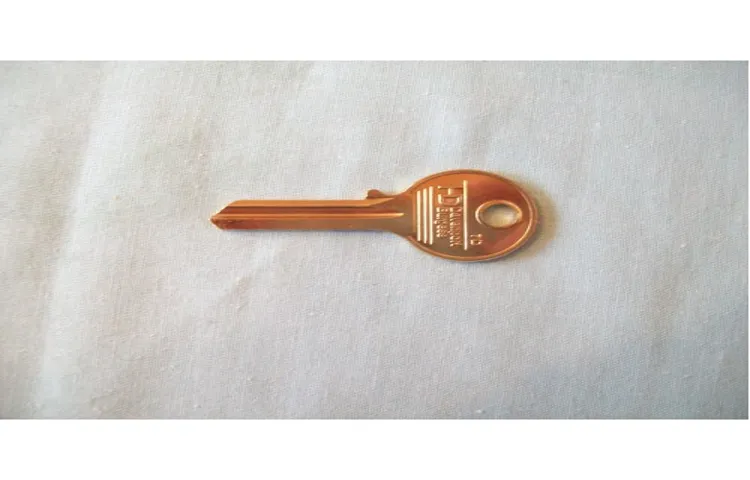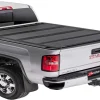So you’ve invested in a hitch cargo carrier to increase the storage capacity of your vehicle. That’s a smart move! But now you’re faced with another challenge – how do you secure your hitch cargo carrier to ensure your belongings stay safe and secure during your journey? Think of your hitch cargo carrier as a sturdy backpack strapped to your vehicle. Just like you would secure your backpack with straps and buckles, you’ll need to do the same with your cargo carrier.
This not only prevents your belongings from shifting during transit but also reduces the risk of theft. One of the simplest and most effective ways to secure your hitch cargo carrier is with the use of ratchet straps or bungee cords. These adjustable straps can be tightly fastened around your cargo carrier, keeping everything in place.
Make sure to distribute the weight evenly and tighten the straps as much as possible to prevent any movement. Another essential step in securing your hitch cargo carrier is to lock it in place. Most cargo carriers come with a locking mechanism that attaches to your vehicle’s hitch receiver.
This not only ensures that the carrier is securely fastened but also provides an extra layer of security against theft. If you’re concerned about the security of your belongings inside the cargo carrier, consider using a cargo net or tarp. These accessories can be used to cover and secure your items, protecting them from dust, wind, and potential prying eyes.
Remember, securing your hitch cargo carrier is not just about protecting your belongings, but also about ensuring the safety of other drivers on the road. A loose or unsecured cargo carrier can pose a significant hazard, especially at high speeds. So, before you hit the road with your hitch cargo carrier, take the time to properly secure it.
Use straps, locks, and covers to keep your belongings safe and prevent any accidents. By doing so, you can enjoy your journey with peace of mind, knowing that everything is secure and well-protected.
Table of Contents
Why Securing Your Hitch Cargo Carrier is Important
Securing your hitch cargo carrier is of utmost importance to ensure the safety of your belongings and the overall stability of your vehicle. When you’re on the road, your hitch cargo carrier is susceptible to various external factors like wind, bumps, and sudden stops. Without proper securing, your cargo carrier could easily become loose or even detach from your vehicle, putting not only your belongings but also other drivers at risk.
So, how do you secure a hitch cargo carrier effectively? Firstly, make sure to choose a cargo carrier that comes with integrated straps or tie-downs. These will provide a convenient and secure way to fasten your cargo to the carrier. Additionally, using bungee cords or cargo nets to hold down any loose items can further prevent them from slipping and potentially causing an accident.
Remember, taking the time to properly secure your hitch cargo carrier is a small yet significant step in ensuring a safe and stress-free journey.
Prevent accidents and injuries
hitch cargo carrier, prevent accidents and injuries, securing your cargo, safety precautions, transportation safety When it comes to transporting heavy items or luggage, a hitch cargo carrier can be a lifesaver. It provides extra space and convenience, allowing you to carry more without sacrificing comfort in your vehicle. However, it’s essential to remember that safety should always be a top priority.
Securing your hitch cargo carrier properly is crucial for preventing accidents and injuries on the road. Imagine what could happen if your cargo suddenly becomes loose and falls off, causing a hazard for other drivers. By taking the necessary safety precautions, you can ensure a smooth and worry-free journey.
Always make sure to tightly secure your cargo carrier to the hitch receiver and double-check all the locks. Use bungee cords or ratchet straps to hold your items in place and prevent them from shifting during transit. Remember, it only takes a little extra time and effort to ensure the safety of your cargo and avoid potential accidents on the road.

Protect your cargo
hitch cargo carrier, secure, cargo, protect Have you ever driven down the highway and noticed loose cargo flying out of someone’s hitch cargo carrier? It’s not only a hazard to other drivers on the road, but it also puts your own cargo at risk. That’s why it’s crucial to secure your hitch cargo carrier properly before hitting the road. Just imagine if your luggage, camping gear, or even your precious sports equipment went flying off your carrier because it wasn’t properly secured.
Not only would it be a nightmare to retrieve, but it could also cause accidents and damage to other vehicles on the road. So, how can you make sure your cargo is protected?
Choosing the Right Hitch Cargo Carrier
When it comes to choosing the right hitch cargo carrier, it’s important to consider how to secure it properly. There are a few different options available, depending on your specific needs and preferences. One option is to use straps or bungee cords to tightly secure the cargo carrier to the hitch.
This helps to ensure that it stays in place during your journey and prevents any shifting or movement. Another option is to use a locking hitch pin, which adds an extra layer of security by preventing anyone from removing the carrier from the hitch. This can be especially useful if you plan on leaving the carrier unattended or overnight.
Finally, some cargo carriers come with built-in locking mechanisms, providing added peace of mind and convenience. Overall, it’s important to carefully consider the security options available and choose the one that best fits your needs to ensure a safe and stress-free trip.
Consider weight capacity
When it comes to choosing the right hitch cargo carrier, weight capacity is an important factor to consider. The weight capacity refers to the maximum amount of weight that the carrier can safely hold. It’s crucial to choose a carrier with a weight capacity that matches or exceeds the weight of the items you plan to transport.
Exceeding the weight capacity can lead to damage to your vehicle or even accidents on the road. On the other hand, choosing a carrier with a lower weight capacity can lead to the items not fitting properly or being securely fastened. So, it’s essential to take the time to assess the weight of your cargo and choose a hitch cargo carrier that can handle it.
Check for sturdy construction
When it comes to choosing the right hitch cargo carrier, one of the most important factors to consider is sturdy construction. You want to make sure that the carrier is built to withstand the weight and demands of your cargo. Look for carriers that are made with high-quality materials such as steel or aluminum, as these materials are known for their strength and durability.
Additionally, check for features such as reinforced corners and strong welds, as these can indicate a carrier that is built to last. By choosing a hitch cargo carrier with sturdy construction, you can have peace of mind knowing that your cargo will be secure and protected during transport.
Measure your vehicle’s hitch size
hitch size, hitch cargo carrier
Securing the Hitch Cargo Carrier to Your Vehicle
So you’ve decided to invest in a hitch cargo carrier for your vehicle, but now you’re wondering how to secure it properly. Don’t worry, we’ve got you covered! Securing a hitch cargo carrier is relatively easy and straightforward. Firstly, make sure your vehicle has a hitch receiver installed.
This is the part of your vehicle that will allow you to attach the cargo carrier. Once you’ve confirmed that you have a hitch receiver, simply insert the shank of the cargo carrier into the receiver and secure it by tightening the hitch pin. The hitch pin will prevent the cargo carrier from wobbling or coming loose during transportation.
Additionally, you may also want to consider using a lock to secure the cargo carrier to prevent theft or unauthorized removal. By following these simple steps, you can rest assured that your hitch cargo carrier is securely attached to your vehicle and ready for your next adventure!
Inspect the hitch receiver
hitch cargo carrier, secure, vehicle When it comes to using a hitch cargo carrier, one of the most important steps is securely attaching it to your vehicle. This starts with inspecting the hitch receiver to ensure it is in good condition and capable of supporting the weight of the carrier and its contents. A hitch receiver is the metal square or rectangular tube attached to the rear of your vehicle, and it is what the cargo carrier will be connected to.
Begin by visually inspecting the hitch receiver for any signs of damage or rust. If you notice any cracks or excessive wear, it’s important to address these issues before attempting to attach the cargo carrier. Additionally, make sure that the hitch receiver is clean and free of any debris that could prevent a secure connection.
Remember, a strong and secure attachment is crucial for the safety of your cargo and the stability of your vehicle while on the road. So, take the time to inspect the hitch receiver thoroughly before attaching your hitch cargo carrier.
Attach the cargo carrier to the hitch receiver
hitch cargo carrier, securing, hitch receiver, attach, vehicle
Tighten the hitch pin or lock
hitch cargo carrier, securing, vehicle
Use stabilizing straps or bars
One important step when using a hitch cargo carrier is to secure it properly to your vehicle. This can be done by using stabilizing straps or bars. These straps or bars can help prevent the cargo carrier from shifting or bouncing while you’re driving, which can be dangerous.
They provide extra support and stability, ensuring that your cargo remains securely in place. Think of them as the “seatbelt” for your cargo carrier, keeping everything in its place and preventing any mishaps on the road. So, before hitting the road with your hitch cargo carrier, make sure to invest in some good quality stabilizing straps or bars to keep your cargo safe and secure.
Securing Your Cargo on the Hitch Carrier
Securing Your Cargo on the Hitch Carrier So, you’re planning a road trip and have decided to use a hitch carrier to transport your cargo. That’s a great choice! Hitch carriers are a convenient and space-saving option for carrying extra luggage, coolers, or even bikes. But how do you ensure that your cargo is secure and won’t get damaged or lost along the way? Well, there are a few key steps you can take to make sure everything stays in place.
Firstly, it’s essential to choose the right size and type of hitch carrier for your needs. Consider the weight and dimensions of your cargo and make sure they align with the capacity and dimensions of the carrier. This will ensure that your cargo fits securely on the carrier without risking any overhang or instability.
Once you’ve chosen the appropriate carrier, it’s time to secure the cargo itself. Start by packing your items tightly and using bungee cords or cargo nets to hold everything in place. This will prevent any shifting or movement during transit.
Additionally, consider using ratchet straps or tie-downs to further secure your cargo. These can be attached to the carrier itself or to the vehicle’s hitch receiver for added stability. Remember to distribute the weight evenly across the carrier and avoid placing too much weight on one side.
This will help maintain balance and prevent any swaying or tilting while driving. If you’re carrying bikes, make sure to use additional bike racks or adapters specifically designed for hitch carriers to secure them properly. Lastly, always double-check everything before hitting the road.
Give your cargo a slight tug to ensure it’s secure and won’t come loose during your journey. Also, check that all straps, cords, and tie-downs are tightened and properly fastened. By following these simple steps, you can have peace of mind knowing that your cargo is securely fastened to the hitch carrier and will arrive at your destination safe and sound.
Use cargo straps or bungee cords
Securing Your Cargo on the Hitch Carrier When it comes to transporting your cargo on a hitch carrier, making sure it is securely fastened is crucial. You don’t want any surprises along the way, like your precious cargo flying off into the oncoming traffic. That’s where cargo straps or bungee cords come in handy.
These handy tools can be easily attached to your hitch carrier and provide the extra security needed to keep your items in place. Cargo straps are made from durable materials like nylon or polyester and are designed to hold your cargo tightly. They typically have adjustable buckles or hooks that make it easy to tighten and secure your load.
Bungee cords, on the other hand, are elastic and can stretch to accommodate different sizes of cargo. They are great for holding down lighter items that may shift during transport. Using cargo straps or bungee cords is simple.
Start by placing your cargo on the hitch carrier and arranging it in a way that allows for even weight distribution. Next, attach the straps or bungee cords to the hooks on the carrier and wrap them around your cargo. Tighten the straps or cords until your cargo is secure and doesn’t move when you give it a gentle shake.
It’s important to remember that different types of cargo require different securing methods. For example, if you are transporting bicycles, you may need specially designed bike straps or racks to hold them in place. Likewise, if you have oddly shaped items, you may need to use additional padding or foam to prevent them from sliding around.
Securing your cargo on the hitch carrier may seem like a hassle, but it is well worth the effort. By using cargo straps or bungee cords, you can have peace of mind knowing that your items will stay put throughout your journey. So, the next time you need to transport your cargo, don’t forget to secure it properly and enjoy a stress-free trip.
Distribute weight evenly
When it comes to securing your cargo on a hitch carrier, one important thing to keep in mind is to distribute the weight evenly. This means ensuring that the weight of your cargo is spread out across the carrier, rather than concentrated in one area. Distributing the weight evenly helps to maintain stability and balance, which is crucial for a safe and smooth ride.
If the weight is unevenly distributed, it can cause the carrier to become unbalanced, which can lead to swaying, wobbling, or even tipping over. To distribute the weight evenly, you can place heavier items in the center of the carrier and lighter items towards the edges. Additionally, you may want to use straps or bungee cords to secure the cargo in place and prevent it from shifting during transit.
By taking the time to distribute the weight evenly, you can ensure that your cargo remains secure and your journey is a safe one.
Consider using a cargo net
hitch carrier, cargo net, securing cargo
Additional Security Measures
When it comes to securing your hitch cargo carrier, there are a few additional measures you can take for added safety and peace of mind. One important step is to use a lock or pin to secure the carrier to the hitch receiver. This will prevent anyone from being able to detach the carrier while you’re driving.
Additionally, you can also consider using straps or bungee cords to further secure your cargo to the carrier. This will help prevent any shifting or movement while you’re on the road. Another option to consider is investing in a cargo net or cargo bag to keep your items contained and secure during transit.
These additional security measures can go a long way in ensuring that your hitch cargo carrier and its contents stay safe and secure while you’re on the go.
Use a hitch lock
hitch lock, additional security measures, prevent theft, peace of mind. One additional security measure you can take to safeguard your trailer or vehicle is to use a hitch lock. A hitch lock is a simple yet effective device that can prevent theft by securing your trailer hitch and preventing anyone from attaching it to their own vehicle.
It provides an extra layer of protection and gives you peace of mind knowing that your trailer is secure when you’re not around. Just like using a lock on your front door, using a hitch lock adds a deterrent factor and makes it much more difficult for someone to steal your trailer. With a variety of hitch lock options available on the market, it’s important to choose one that fits your specific hitch and offers the level of security you desire.
So, next time you’re planning a trip with your trailer, don’t forget to invest in a hitch lock for that extra peace of mind.
Consider adding a cargo carrier bag or cover
In addition to using a rooftop cargo carrier, you may also want to consider adding a cargo carrier bag or cover for extra security. These accessories can help protect your belongings from the elements and prevent them from shifting or flying off during transit. A cargo carrier bag is made of durable and waterproof material, ensuring that your items stay dry even in rainy weather.
It also provides an extra layer of protection against dust and dirt. On the other hand, a cargo carrier cover is designed to fit snugly over your cargo carrier, providing an added barrier against wind resistance and potential theft. With these additional security measures, you can have peace of mind knowing that your belongings are safe and secure on your next road trip or adventure.
Conclusion
In conclusion, securing your hitch cargo carrier is not just about keeping your belongings safe and in place, it’s a strategic dance between creativity and practicality. It requires the finesse of a master puzzle solver, the strength of a weightlifter, and the ingenuity of MacGyver. But fear not, dear reader, for armed with this guide, you are now equipped to tackle this task with the grace and skill of a seasoned cargo-carrying ninja.
So go forth, my friend, and may your journeys be hitched securely, your cargo never jostled, and your witty explanations always make heads turn!”
FAQs
How to secure a hitch cargo carrier to my vehicle?
To secure a hitch cargo carrier to your vehicle, follow these steps:
– Position the carrier in the hitch receiver and align the holes.
– Insert a hitch pin or lock through the holes to secure the carrier.
– Tighten any bolts or straps provided to keep the carrier in place.
– Double-check the security of the carrier before driving.
What are the best ways to prevent theft of a hitch cargo carrier?
To prevent theft of a hitch cargo carrier, you can:
– Use a hitch lock to secure the carrier to your vehicle’s hitch receiver.
– Remove the carrier when it’s not in use and store it in a secure location.
– Park your vehicle in well-lit and populated areas to deter theft.
– Consider using a hitch lock with an alarm or tamper detection feature.
Can I install a hitch cargo carrier on any type of vehicle?
In most cases, you can install a hitch cargo carrier on any vehicle that has a hitch receiver. However, it’s important to check the weight capacity of both your vehicle’s hitch and the carrier itself to ensure compatibility.
Are hitch cargo carriers safe to use while driving?
When installed properly and within the weight limits specified by the manufacturer, hitch cargo carriers are generally safe to use while driving. However, it’s important to secure the load tightly and distribute the weight evenly to maintain stability and prevent any accidents or damage.
Can I use a hitch cargo carrier on an SUV or truck with a spare tire on the back?
Yes, you can use a hitch cargo carrier on a vehicle with a spare tire on the back. Some cargo carriers are designed with a foldable or adjustable design that allows clearance for the spare tire. Make sure to verify the dimensions and specifications of the carrier to ensure compatibility with your vehicle.
Are there any weight restrictions when using a hitch cargo carrier?
Yes, there are weight restrictions when using a hitch cargo carrier. The weight limit will vary depending on the specific carrier and the hitch receiver on your vehicle. Always check the manufacturer’s guidelines to ensure you do not exceed the recommended weight capacity.
Can I use a hitch cargo carrier for transporting fuel or hazardous materials?
It is not recommended to use a hitch cargo carrier for transporting fuel or hazardous materials unless it is specifically designed and labeled for that purpose. Using a carrier that is not designed for such materials can pose safety risks and may be illegal.
How can I protect my hitch cargo carrier from the elements? A8. To protect your hitch cargo carrier from the elements, you can: – Use a weatherproof cargo bag or cover to shield the contents from rain and snow. – Apply a rust-resistant coating or paint to the carrier to prevent corrosion. – Store the carrier in a garage or covered area when not in use.
Can I use a hitch cargo carrier with a bike rack or other attachments?
Yes, many hitch cargo carriers are designed to accommodate additional attachments like bike racks or cargo boxes. However, it’s important to ensure that the combined weight of the carrier and any attachments does not exceed the weight capacity of your vehicle’s hitch and the carrier itself.
How should I load and balance items on a hitch cargo carrier?
When loading items on a hitch cargo carrier, it’s important to:
– Distribute the weight evenly from side to side to maintain balance.
– Place heavier items at the bottom of the carrier and lighter items on top.
– Secure the load with straps or bungee cords to prevent shifting during transit.
– Avoid overloading the carrier and exceeding the weight capacity.



